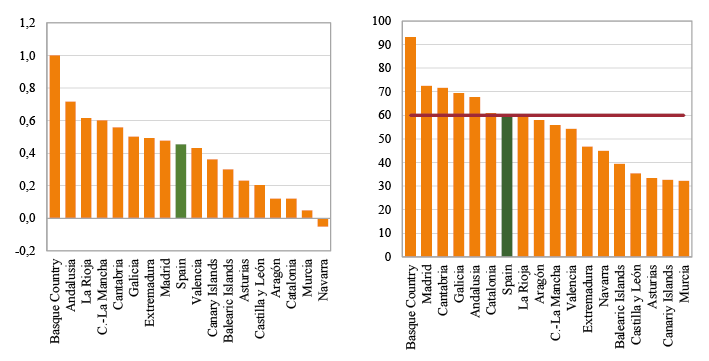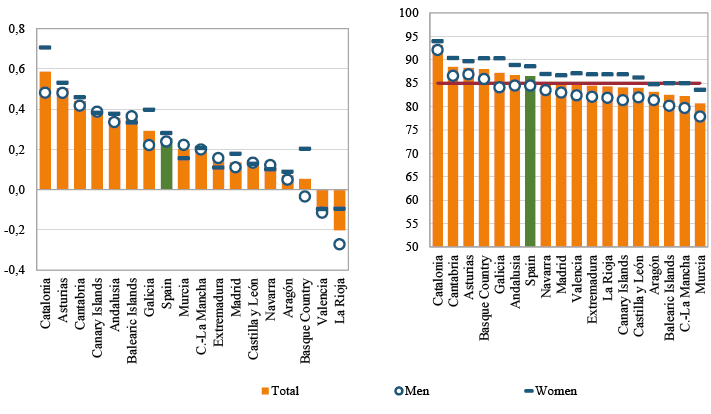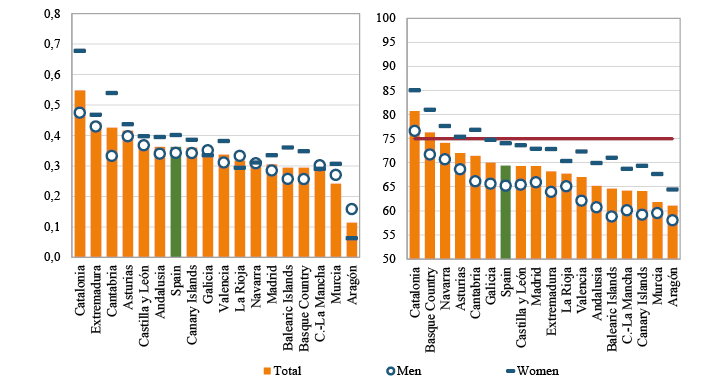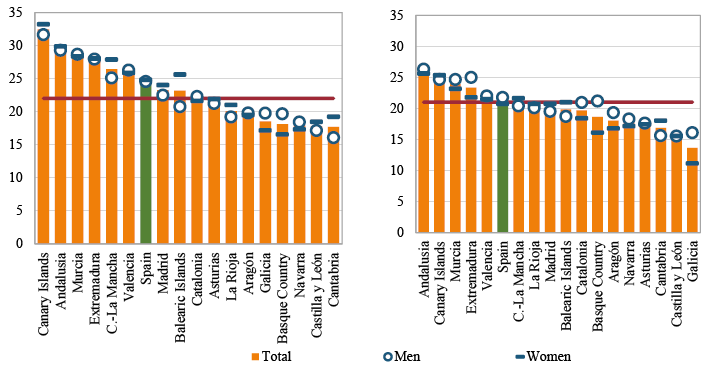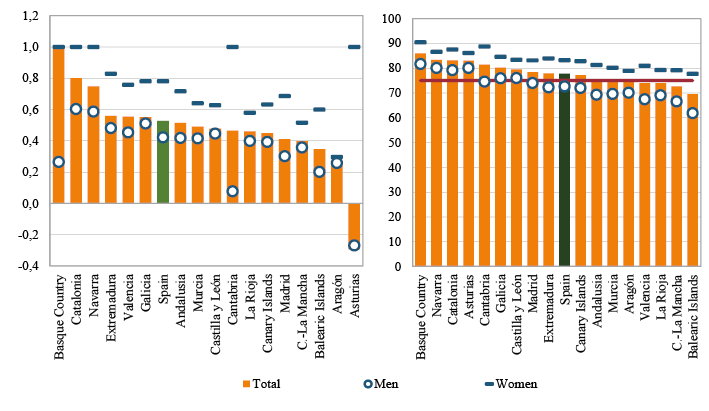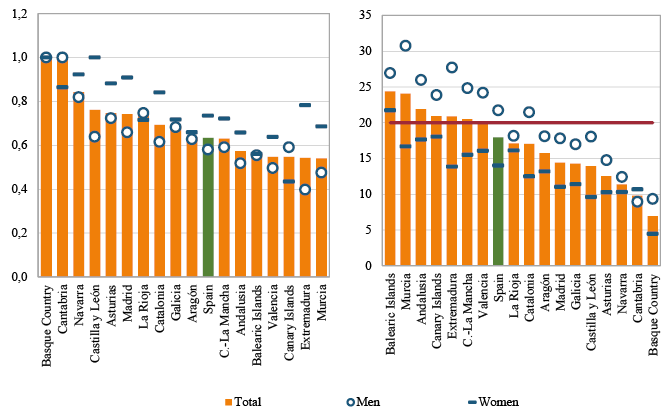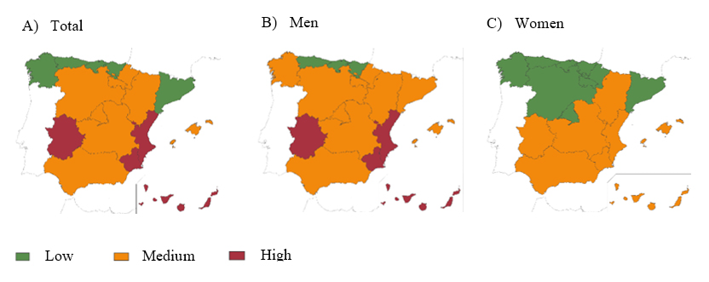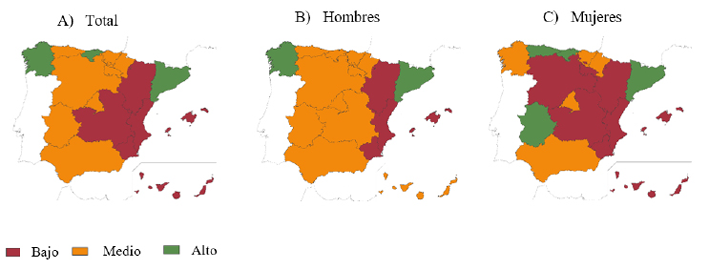Gender and regions in the vicious circle of school failure 1
Género y territorio en el círculo vicioso del fracaso escolar
https://doi.org/10.4438/1988-592X-RE-2022-398-558
Jorge Fernández-Herrero
https://orcid.org/0000-0003-1545-8906
Universidad de Alicante, Departamento de Didáctica General y Didácticas Específicas
Carmen Herrero
https://orcid.org/0000-0002-5261-3277
Universidad de Alicante, FAE e Instituto Valenciano de Investigaciones Económicas
Ángel Soler
https://orcid.org/0000-0003-3721-6692
Universidad de Valencia, Departamento de Economía Aplicada e Instituto Valenciano de Investigaciones
Económicas
Abstract
This article analyses the regional and gender situation of compulsory education in Spain, in line with the Sustainable Development Goals (SDGs) and considering two important aspects: on the one hand, detecting basic deficiencies, coining the term educational poverty; on the other hand, measuring recent evolution, introducing the idea of progress. METHOD. As variables, we take school enrolment at two years of age, suitability rates at 12 and 15 years of age, school failure, and early school leaving, in 2008 and 2018, as well as the percentages of low performers in Mathematics and Science in PISA 2018. Given the targets for each variable, related to the 2020 Strategy, as well as scarcity thresholds, we define both progress and poverty indexes, using data from the Ministry of Education and Vocational Training 2020 and the PISA 2018 report. RESULTS: Females perform better than males in all variables except PISA Mathematics. The Canary Islands, Murcia, the Valencian Community, and Extremadura showed extreme educational poverty in 2018. The regions of the Cantabrian coast and Catalonia did not show poverty. The regions worst placed in poverty made the least progress over the period, although all regions did make progress. DISCUSSION AND CONCLUSIONS: The concepts of poverty and educational progress provide a nuanced view of the situation and problems of compulsory education. Differences between Spanish regions are maintained over the period, with a very weak Beta convergence. The gender differences detected may respond to deeply rooted socio-economic roles. Early education appears as an important element to improve later outcomes. Productive specialization and economic status influence early drop-out. Reducing poverty figures requires measures involving the holistic development of the student.
Keywords: educational improvement, educational poverty, compulsory education, gender differences, regional differences
Resumen
En este artículo analizamos la situación regional y con perspectiva de género de la educación obligatoria en España, de acuerdo con los Objetivos de Desarrollo Sostenible (ODS), considerando dos aspectos importantes: por una parte, detectando las carencias básicas, acuñando el término pobreza educativa; por otra, midiendo la evolución reciente, introduciendo la idea de progreso. MÉTODO. Como variables, se toman la escolarización a los dos años, tasas de idoneidad a los 12 y 15 años, fracaso escolar, y abandono educativo temprano, en 2008 y 2018, así como los porcentajes de bajo desempeño en PISA 2018 en Matemáticas y Ciencias. Fijados unos objetivos en cada variable, relacionados con la Estrategia 2020, así como umbrales de escasez, definimos un índice de progreso y pobreza, utilizando los datos del Ministerio de Educación y Formación Profesional 2020 y del informe PISA 2018. RESULTADOS: Las mujeres presentan mejores resultados que los hombres en todas las variables, salvo en PISA Matemáticas. Canarias, Murcia, la Comunidad Valenciana y Extremadura presentan pobreza educativa extrema en 2018. Las regiones de la cornisa Cantábrica y Cataluña no presentan pobreza. Las regiones peor situadas en pobreza son las que han progresado menos en el periodo, aunque todas las regiones han progresado. DISCUSION Y CONCLUSIONES: Los conceptos de pobreza y progreso educativos permiten obtener una visión matizada de la situación y problemas de la educación obligatoria. Las diferencias entre las regiones españolas se mantienen en el periodo, con una Beta convergencia muy débil. Las diferencias de género detectadas pueden responder a roles socioeconómicos fuertemente arraigados. La educación temprana aparece como un elemento importante para mejorar los resultados posteriores. La especialización productiva y la situación económica influyen en el abandono temprano. La reducción de las cifras de pobreza requiere medidas que impliquen el desarrollo integral del alumno.
Palabras clave: progreso educativo, pobreza educativa, educación obligatoria, diferencias de género, diferencias regionales
Introduction
The United Nations Sustainable Development Goals (SDGs) highlight the necessary transformations that societies face in social, economic, and environmental spheres. The achievement of these goals has turned human capital, in terms of acquired knowledge, into the most crucial asset in neighbouring countries (Ortega & Cortés, 2017). At the same time, profound changes are appearing in the learning and teaching processes, as well as new forms of knowledge and skills linked to technological changes and new forms of social interaction (Crittenden et al., 2019).
Education is the instrument that most powerfully contributes to a country’s progress, social mobility, and equity. Only a society with sufficiently knowledgeable citizens can harness the dissemination and use of new technologies (Hanushek & Woessmann, 2011). The relationships between knowledge, education, and job opportunities, both at the individual and societal level, and their contribution to the growth and progress of countries are well documented and studied (Karasiotou, 2012).
However, for education to play a relevant role in individual and social progress, it needs to promote equal opportunities (González & Marcenaro, 2018). Education in the early stages of life is one of the elements currently in the spotlight, as achieving an adequate education in adulthood largely depends on the quality of the initial training received. This stage is when the neurophysiological bases that determine later psychological processes are structured (Gutiérrez & Ruiz, 2018), an aspect that has crucial influences on later academic results, health, and well-being (Sims, 2020).
Among the SDGs for 2030, Targets 4.1 and 4.2 include, first, ensuring that every girl and boy has access to quality early childhood care and development services and preschool education. Second, ensuring that they complete primary and secondary education levels within free, equitable and good quality standards. And, third, producing effective learning outcomes. In turn, SDG5 stresses the need to achieve gender equality and women’s empowerment. In particular, in education, positive differences in favour of women are identified, which, however, do not translate into the labour market (Dancausa et al., 2021).
Compulsory education in Spain is problematic in several respects. Education policies depend on autonomous communities, and among them, economic heterogeneity leads to differences in resources to finance public education (López et al., 2016; González & Marcenaro, 2018). Moreover, the contrast in production structures and the labour market between regions influence dropout rates and the quality of education (Oliver & Roselló, 2019). On the other hand, the Spanish educational system, unlike its neighbours, suffers in some significant aspects, such as the high repetition rate, the high dropout rates, and the improvable results in the PISA tests (Choi & Calero, 2013). Nevertheless, recognizing that PISA is a benchmark of great international weight, its validity and reliability should be interpreted with caution (Fernández-Cano, 2016).
The importance of early schooling on cognitive development, social behaviour, and emotional maturity are well known (Bakken et al., 2017). In particular, this factor is essential for children from disadvantaged backgrounds (Ansari et al., 2019) as well as for later academic success (Shala, 2013), especially in the case of immigrant children (Corazzini et al., 2021). The relevance of acquiring particular skills for later numerical development is also highlighted (Cahoon et al., 2021).
Several studies support the importance of learning and success in school at the 12-15 years stage for developing future skills, career aspirations, and success in accessing the labour market (Basler & Kriesi, 2019; Manić & Trajković, 2019). Delay and grade repetition have significant effects on students’ motivation (Cabrera et al., 2019) and lead to and accentuate social inequalities (González & Marcenaro, 2018), especially among immigrants (Bayona-i-Carrasco & Domingo, 2021), and therefore represent a critical barrier to equity. Spain has the highest grade repetition rates in the Organisation for Economic Cooperation and Development (OECD) countries (Cabrera et al., 2019).
A worrying element of the Spanish situation is the so-called administrative school failure, i.e. people who finish compulsory schooling without obtaining the ESO [Compulsory Secondary Education] diploma. This leads to high levels of social and labour market exclusion (Antelm et al., 2018).
School failure is closely related to the high number of young people who leave education early, with fatal consequences for future employment and personal development, as well as for the productive system and human capital of society (Calero & Fernández 2012; Fernández & Calero, 2014). Therefore, reducing early school dropouts poses a challenge for educational policies. Not in vain, it fundamentally affects the most vulnerable groups with labour market insertion among their greatest problems, and is the main factor of exclusion in the Spanish education system.
This paper analyses the situation of compulsory education in Spain in its most essential aspects. Looking at the basic indicators (participation rates; suitability; attainment of the Compulsory Secondary Education [ESO] certificate; PISA test results; early drop-out), two questions arise:
- How different is the situation between autonomous communities? Is there a sufficient basic level of education? And are there communities whose results are clearly below expectations?
- What has been the situation’s evolution within the communities in recent years? Can it be said that all regions have made positive progress in their basic educational outcomes? Which regions have progressed the most?
At the same time, this article aims to provide a gender perspective on the compulsory education situation, analysing the differential situation of both sexes.
To answer these questions, two novel concepts – educational poverty and educational progress –are introduced. It is important to note that these concepts refer to societies, not individuals, unlike those related to material poverty.
We start by considering that poverty is partly associated with what the OECD calls the “vicious circle of school failure”, understood as a cumulative process of disengagement from the education system, comprising different ages, and various manifestations.
This paper focuses on Spain’s early compulsory schooling and its situation in the different autonomous communities. In this sense, basic education understood as a dynamic process leads to several critical milestones being closely considered: Early education (before the compulsory stage), the end of primary education, and the end of secondary education (ESO)
Method
Variables
Generally speaking, educational deprivation (or poverty) in a society with universal access to compulsory education is often associated with functional illiteracy, school failure, and early drop-out from education and training. However, in this cumulative process, we will also consider the extension of early schooling (2 years), adequate progress in primary and secondary education, and the acquisition of sufficient levels of competencies in reading comprehension, mathematics, and science.
The Ministry of Education and Vocational Training provides annual statistics on variables that approximate the above-mentioned: education rates at age 2, suitability rates at ages 12 and 15, school failure, and early dropout (Ministry of Education and Vocational Training, 2020). These variables, corresponding to 2008 and 2018, are used to calculate educational progress. Each variable depends on two bounding parameters. The first, the target is determined by the 2020 Strategy. The second, the poverty threshold ranges between 10 and 20% below the target depending on the data.
We use PISA data as the most appropriate source to approximate the sufficient acquisition of reading literacy, mathematics, and science for Spanish regions in a comparable way. The PISA 2018 results in mathematics and science are used, together with data on the above variables in 2018, to analyse poverty. The selected poverty thresholds link to the OECD average proportion of low-performing students in the PISA variables.
Measuring educational poverty
The concept of material poverty is linked to the lack of essential goods (or the ability to acquire them) by particular individuals in a population. When considering poverty income, a certain threshold is defined, below which the population is considered “poor”. This threshold starts at 60% of the country’s average income within developed countries. Recently, multidimensional indicators of material poverty have been developed, such as the AROPE (At Risk of Poverty and Social Exclusion) defined by the European Union in the Europe 2020 Strategy based on data provided by the EU-SILC (European Union Survey on Income and Living Conditions). The United Nations considers a multidimensional concept of poverty in which unmet basic needs are specified, including elements of health and education, as households with out-of-school children or insufficient schooling years (United Nations Development Programme [UNDP], & Oxford Poverty and Human Development Initiative [OPHI], 2021). Both indicators consider the accumulation or existence of any deprivation at the individual or household level and count the number of individuals or households living in poverty.
This paper applies a similar methodology to assess the situation of compulsory education at a societal level (Spain and its autonomous communities). To do so, and for each of the variables that “monitor” the evolution of educational deprivation, we define a threshold delimiting the figures that society should not exceed. Poverty, in this case, is measured in a given year, 2018. Any community under review qualifies as poor in a given variable when it does not reach a predetermined level which we will call the poverty threshold for that particular variable.
A society must show significant deprivation in at least three of the seven selected indicators to be considered poor in education. A society presents extreme poor conditions with deprivation in 6 or 7 of the selected indicators, medium poor if it is in 3-4-5 of them, and weakly poor if it is in 2 or fewer indicators.
Measuring educational progress
We measure progress by looking at relative differences in the variables considered over the last ten years. Progress is present if advancements are in the right direction. We understand it to be fulfilled (index 1) if it achieves the target proposed in the 2020 Strategy. Specifically, we consider the values of the corresponding variables at two points in time, in our case, t_1=2008; t_2=2018, as well as the target value of the indicator. We use these data to build a progress index as follows:
If the indicator (variable) is such that it is good to increase its values over time,
If the indicator is such that it is good to decrease its values over time,
Note that the index is always between 0 and 1. It reaches a value of 1 when the target has been reached (or exceeded). On the other hand, we can speak of beta convergence when regions that start low at one particular variable progress more than those whose initial data are better (Sala-i-Martín, 2000).
Table I specifies the variables considered and the targets for measuring progress and poverty lines.
TABLE I. Variables, progress targets, and poverty thresholds
|
Target |
Poverty threshold |
|
|
Enrolment rates at age 2 |
90.0% |
60.0% |
|
Suitability rate at age 12 |
95.0% |
85.0% |
|
Suitability rate at age 15 |
90.0% |
75.0% |
|
Students lagging behind in mathematics |
22.0% |
|
|
Students lagging behind in science |
21.0% |
|
|
Gross rate of population completing secondary education * |
85.3% |
75.0% |
|
Early school leaving rate |
10.0% |
20.0% |
* Complementary to the school failure rate
Source: Own elaboration.
Data sources
Territorial and gender disaggregation is available for the rest of the variables considered, except for enrolment rates in early childhood education, with no gender-differentiated data. Considering the data for 2008 and 2018, progress in every variable and territory can be established, both in aggregate and for men and women separately. On the other hand, we can determine the scarcity levels in all the variables for 2018, obtaining a picture of educational poverty in that year.
The information used comes from official administrative records published in “Las cifras de la Educación en España” (Ministry of Education and Vocational Training, 2020), except for data assessing Mathematics and Science competencies in 2018, which come from PISA results (OECD, 2020).
Results
Early schooling
While there is some debate about when schooling should start (Becker & Schober, 2017), universal access to quality pre-primary education stands out among the SDGs. This paper considers enrolment rates at age two as a proxy for early education.
In Spain, the enrolment rate at the age of 2 was 35% in 2008 and only the Basque Country had a rate of 90%. The situation was particularly worrying in the Canary Islands, Castilla-La Mancha, and Extremadura (below 5%). A comparison of the 2008 and 2018 data shows that, in 2018, the school enrolment rate in the country was 60%, a significant advance but still falling far short of the 90% target. The only region that continued to meet the target was the Basque Country, but all except Navarra have made progress in this period.
On the other hand, most of the communities in 2018 are below this threshold (Figure 1) in this variable, where the poverty threshold is at 60%, except for Andalusia, Cantabria, Catalonia, Galicia, Madrid, and the Basque Country.
FIGURE I. Progress and poverty index. School enrolment rate of the 2-year-old population. Autonomous Communities. Academic years 2007/08 and 2017/18
A) Progress rate. 2008-2018 B) Poverty. 2018
Source: Ministry of Education and Vocational Training (2020) and own elaboration.
Suitability rates at 12 and 15 years of age
Suitability rates at each age show the percentage of pupils making adequate progress during compulsory schooling and completing the corresponding grade at the target age. A systemic problem in Spain has been grade repetition, which stands at over 30% (Choi et al., 2018). Thus, the suitability rates in Spain have consistently been the worst among OECD countries (Cabrera et al., 2019). This section considers suitability rates at the end of primary school (age 12) and in the last year of ESO (age 15).
Given the target is 95% at the age of 12 and 90% at the age of 15, Spain deeply undermeets these targets. At the age of 12, Spain has gone from 83.6% to 86.5%, and at the age of 15, from 57.7% to 69.4%. No region has reached the target, but practically all of them have made progress in the period analysed (Figures II and III), although it is relevant to note the increase in the flexibility of education policies in terms of grade repetition (LOE, 2006; LOMCE, 2013 and LOMLOE, 2020).Only Andalusia, the Balearic Islands, Asturias, and the Canary Islands out of the Autonomous Communities with the worst data in 2008 progressed above the national average.
In terms of progress in suitability rates at the age of 15, only Asturias and Castilla y León, starting from worse data than the national average in 2008, have progressed above average.
At the age of 12, a recurrent phenomenon begins to be detected: when disaggregating the data by gender, girls have, from the outset, performed better than their male peers. At 12 years of age in 2008, girls were 5 points on average ahead of boys, with an advantage of more than 8 points in the Canary Islands, Murcia, and the Balearic Islands. In 2018, girls’ advantage was 4.1 points on average, with Galicia, the Canary Islands, Murcia, and Castilla-La Mancha above 5.3.
As regards suitability rates at 15, the girls’ advantage on average was 11 points in 2008, with Galicia, Extremadura, the Canary Islands, the Balearic Islands, and Castilla-La Mancha above 12.3 points. In 2018, the difference in favour of girls was 8.8 points, with girls in the Balearic Islands, Cantabria, the Canary Islands, and the Valencian Community more than 10 points ahead of boys.
Women has also progressed more than men, except in Murcia and Extremadura at age 12, and in Galicia, La Rioja and Castilla-La Mancha at age 15.
In terms of poverty, while only Aragon and Murcia show poverty at age 12 for females, the situation is much worse for males at both ages, and both sexes at age 15, with only Catalonia and the Basque Country showing no poverty in these variables.
FIGURE II. Progress and poverty index. Suitability rate at age 12. Autonomous Communities. Academic years 2007/08 and 2017/18
A) Progress rate. 2008-2018 B) Poverty. 2018
Source: Ministry of Education and Vocational Training (2020) and own elaboration.
FIGURE III. Progress and poverty index. Suitability rates at age 15. Autonomous Communities. The academic year 2007/08 and 2017/18
A) Progress rate. 2008-2018 B) Poverty. 2018
Source: Ministry of Education and Vocational Training (2020) and own elaboration.
The PISA 2018 reports
At this point, it is important to determine whether the suitability rates adequately reflect the quality of education received by students, so we complete the picture of the shortfall situation in 2018 with the results of the PISA tests in the 2018 wave in both Mathematics and Science.
The PISA programme considers low performers to be students whose scores are below level 2 of the 7 levels into which PISA classifies student performance. In this regard, it is interesting to note that some authors identify this situation with school failure (Choi & Calero, 2013).
In Mathematics (Figure IV), the situation in Spain in 2018 is worrying, with 24.7% of students scoring low. The Canary Islands, Andalusia, Murcia, and Extremadura stand out for having the highest percentages, both in males and females. However, unlike the rest of the variables analysed, men obtain better results here than women, with an average difference of 0.3 percentage points in favour of men, as is the case in general (Ó Siochrú, 2018).
In Science, the situation is similar, although less accentuated, as 21.3% of students in Spain are in the low-performance levels. Nevertheless, on average, the advantage is in favour of females by one percentage point. However, not all regions show a smaller percentage of low women achievers: in the Balearic Islands, the Canary Islands, Cantabria, Castilla-La Mancha, La Rioja, and Madrid, the results of men are better than those of women. The communities with the worst outcomes are the same as those in Mathematics.
While these results are partly in line with the 15-year-old proficiency rates, the picture they present has relevant differences. Aragon poses a significant case, with the worst results in proficiency rates at age 15, but good PISA results in both subjects.
To set the poverty thresholds from the PISA data, we considered the percentage average of low-performing students in the European Union to correspond to 22% in Mathematics and 21% in Science. Under this criterion, nine regions stand out for not showing poverty either in Mathematics or Science: Catalonia, Aragon, La Rioja, the Basque Country, Navarra, Cantabria, Asturias, Castilla y Leon, and Galicia. On the other hand, in Science, Madrid, Castilla-La Mancha, and the Balearic Islands would not be below the poverty line either. In contrast, Andalusia, the Canary Islands, Extremadura, the Valencian Community, and Murcia are below the poverty line in PISA in both subjects, as well as in proficiency rates at age 15.
In the analysis of the results differentiated by gender, the Canary Islands, Andalusia, Extremadura, Murcia, Castilla-La Mancha, and the Valencian Community show poverty among males and females in both subjects. On the other hand, Catalonia presents male poverty in both areas whereas the Balearic Islands show female poverty in both disciplines. In addition, the Basque Country shows poverty for males in Mathematics.
FIGURE IV. Poverty. Low performance in PISA. Autonomous Communities 2018.
A) Mathematics B) Science
Source: OECD (2020) and own elaboration.
School failure
As mentioned above, there are several options for analysing school failure (García, 2017). In this section, we opt for a standard version of the term school failure, the so-called administrative school failure, understood as a situation in which the student attempts to achieve the minimum objectives set by the institution - those of compulsory secondary education - and withdraws without having achieved them.
School failure in Spain is at very high levels, although it is true that it has fallen in the last 10 years, from 30.6% in 2008 to 22.2% in 2018. The differences between men and women are more than 10 percentage points, with men showing a clear disadvantage.
The Ministry of Education and Vocational Training provides data on the gross rate of the population completing ESO, which measures the population completing compulsory education. We here consider this variable complementary as a proxy for school failure. The threshold to be reached in 2020 was set at 85.3%, in line with the 2020 Strategy objectives, to calculate this indicator’s progress rate. Although all the Communities, except Asturias, are making progress in this variable (Figure V), it is worth noting that, only the Valencian Community and Extremadura out of the Communities that started with the worst values in 2008 are making above-average progress in this variable, and beta convergence is therefore very weak.
One of the messages standing out again is the difference between men and women. Women show better values in this indicator than men in all regions. Furthermore, women reached the target value in five regions, four of which belong to the Cantabrian coast, unlike men in any other Spanish community in 2018.
In terms of poverty, with a threshold of 75% of pupils completing ESO, the Balearic Islands, Castilla-La Mancha, and La Rioja are below the threshold for the general population. While no region has female poverty in this variable, in the case of males, only Asturias, Cantabria, Castilla y Leon, Catalonia, Galicia, the Basque Country, and Navarra are free of poverty in this variable.
FIGURE V. Progress and poverty index. Gross rate of the population completing ESO by sex. Autonomous Communities. Academic year 2007/08 and 2017/18
A) Progress rate. 2008-2018 B) Poverty. 2018
Source: Ministry of Education and Vocational Training (2020) and own elaboration.
Early school dropout
The early school leaving rate (ESL) summarizes the consequences of the educational problems discussed above, since enrolment rates at age 2, suitability rates at ages 12 and 15, and school failure directly affect the ESL.
To calculate the ESL progress rate, we consider the 10% established by the European Union as the ET2020 as the threshold target to reach. It is noteworthy that all Spanish regions have experienced progress. And some, such as the Basque Country and Cantabria, managed to fulfil the target.
Once again, women showed a comparative advantage over men (Figure VI), with a higher rate of progress except in Cantabria, La Rioja, and the Canary Islands. Men only progressed above the national average in Catalonia and Extremadura, among the worst-placed regions in 2008. On the other hand, the regions with the highest rate of progress for the general population are the Basque Country, Cantabria, Navarra, Castilla y Leon, Asturias, and Madrid, which have the lowest ESL rates. This shows the absence of beta convergence between the Spanish regions for this variable.
FIGURE VI. Progress and poverty index. Early school leavers. Autonomous Communities. 2008-2018
A) Progress rate. 2008-2018 B) Poverty. 2018
Source: INE and own elaboration.
The poverty results for this variable partly coincide with poverty in school failure but are more intense. All regions showing poverty in school failure also show dropout poverty, both in the general case and by gender, although females, except in the Balearic Islands, do not show poverty. In the case of males, poverty dropout figures are more widespread across regions and show a strong correlation with school failure.
Summary results
Figures VII and VIII show a summary of the geographical situation of educational poverty in 2018 and educational progress between 2008 and 2018, distinguishing between communities with extreme educational poverty (6-7 variables in which the community is poor), medium poverty (3-4-5 variables in which poverty appears), or without educational poverty (0-1-2 variables in which poverty appears). When representing progress, we differentiate communities between strong progress (4-5 variables where the community progresses above the national average), moderate progress (2- 3 variables of progress above average), and weak progress (0-1 variables of progress above average).
FIGURE VII. Educational poverty index. Autonomous regions. 2018
Source: Ministry of Education and Vocational Training (2020), INE, OECD (2020) and own elaboration.
FIGURE VIII. Educational progress index. Autonomous regions. 2008-2018
Source: Ministry of Education and Vocational Training (2020), INE, OECD (2020) and own elaboration
We can observe a very well-defined territorial distribution. Catalonia and the communities of the Cantabrian coast show little poverty and strong progress; in contrast, the Canary Islands, Murcia, and the Valencian Community show extreme poverty and weak progress. Extremadura starts from extreme poverty but shows medium progress. The situation of men is worse than that of women in terms of poverty, but men make more progress in almost all regions.
Discussion
This paper has presented a territorial overview of the situation of compulsory education in Spain and incorporated two novel methodological aspects. On the one hand, the concept of educational progress was included and analyses the trajectories of the different communities between 2008 and 2018. On the other hand, the notion of educational poverty was introduced and highlights the regions that suffer significant shortcomings in compulsory education. The substantial differences between women and men have highlighted the desirability of considering the gender perspective.
In terms of educational progress, it is noticeable that all the regions have made progress in the period but the signs of beta convergence are weak. This implies that the progress speed of the worst-placed regions is not enough to achieve a certain uniformity in the long run, which is consistent with other studies (De la Fuente & Domenech, 2021). Of particular concern is the situation in Murcia, the Valencian Community, Castilla-La Mancha, Aragón, the Canary Islands, and the Balearic Islands, which, relative to the general population, show weak progress. These same regions (except Castilla-La Mancha, Aragon, and the Balearic Islands) plus Extremadura (with medium progress) show extreme poverty in 2018.
In 2008, the data for Andalusia, Extremadura, the Balearic Islands, Castilla-La Mancha, and Murcia was worse than the national average in all the variables considered. The Canary Islands, the Valencian Community, and La Rioja performed under the Spanish average in four variables. Cantabria, Aragon, and Asturias qualified poorly in two of the variables. In 2018, the situation in La Rioja, Cantabria, Aragon, and Asturias was good, while the outcome of the rest continued to be precarious. This indicates that not only the economic conditions of the communities can explain educational outcomes (García & Valls, 2018). In many cases, the territories’ productive conditions may have a negative influence on their educational outcomes, as in the Canary Islands and the Mediterranean regions (Oliver & Roselló, 2019).
The apparent inconsistencies between the PISA results and the proficiency rates may be due to the lack of regional representativeness of PISA. Or otherwise, to methodological or implementation problems that, for example, have made it unfeasible to use the reading data in the Spanish case. It is noteworthy that, as in other waves, the proficiency rates at age 15 are, for all regions, worse than the percentages of students not classified as low achievers according to PISA (García, 2017). This indicates that school failure in Spain may not respond to a lack of knowledge, or a consequence of the numerous methodological problems presented by the PISA programme (Fernández-Cano, 2016).
In terms of gender, consistent with other studies, females perform better than males in all variables except PISA Mathematics (Fuentes & Renobell, 2020). In particular, early school leaving is shown to be a male phenomenon (Fernández & Calero 2014; Serrano et al., 2014; Soler et al., 2021), extensible to the foreign population. Although the divergences described above may be due to multiple and complex factors, overcoming the still socially prevalent gender role differences acts as an incentive for women’s educational efforts (Martínez García, 2021).
In addition, the educational level of parents, especially the mother, and the economic capacity of families have a direct impact on this phenomenon (Bayón et al., 2017). The likelihood of early dropout falls the better educated the parents are.
The above results indicate a high correlation between the different variables chosen to analyse educational progress and poverty, as has already been seen in other studies (García, 2017). The factors that explain these failures can be classified into those relating to students’ socioeconomic and family situation, personal characteristics, regional characteristics, or educational trajectory.
The previous analysis allows us to suggest some educational policy measures already discussed in other studies that may help improve the situation. Women have better academic results than men (except in Mathematics) but greater labour market insertion problems (Dancausa et al., 2021). Lawmakers therefore should implement intervention policies from a gender perspective to minimize stereotype effects (Garrido et al., 2020).
An important issue relates to the particular difficulties of every region, which should include specific plans to avoid the risk of educational failure (taken in its broad sense). For example, to tackle inequality and discrimination, incorporating early education in the public or subsidized systems, or allocating special resources for students from more disadvantaged backgrounds (Rosado & Cáceres, 2018; García & Jiménez, 2019).
Some measures to prevent early failure can be effective, such as encouraging reading at an early age or supporting children born in the third quarter of the year (Cabrera, 2019).
Grade repetition stands out as a negative factor: not only does it fail to improve the quality of the student’s education, but it also increments school failure and has a stigmatizing effect that demotivates students (Cabrera, 2019; Cabrera et al., 2019; García & Jiménez, 2019).
The family environment is of the utmost importance for educational success. It is not enough to implement specific policies for the most disadvantaged families. Schools still need to be involved in this aspect, by providing material, reconciliation policies, and, above all, raising awareness among families so that they feel included in the educational process (Garrido et al., 2020).
Conclusions
This work has allowed a synthetic image of the situation of compulsory education in the Spanish Autonomous Communities, including a gender perspective, to be projected.
The concepts of educational progress and poverty provide a holistic view of the situation and evolution of the problems of compulsory education in Spain and its regions. All regions have shown progress in the variables considered over the period 2008-2018. However, convergence is weak, which indicates homogenization problems in the long term.
Regional differences in educational attainment show a map of educational poverty highly concentrated along the Mediterranean arc, except for Catalonia, as well as in the Canary Islands, Extremadura, and Castilla-La Mancha, where male predominance is high.
The temporal analysis shows that the economic situation is a determining factor in educational progress and poverty, although part of this situation of poverty can be explained by the concentration of production in the tourism sector in some regions. That mainly directs the underqualified male young population to a dynamic labour market, although exposed to fluctuations, as shown by the crisis caused by COVID-19.
Educational performance strongly relates to gender, possibly due to sociocultural aspects not yet overcome. In general (except for PISA results in mathematics proficiency), females perform better than males.
The families’ socio-economic context is a relevant factor in the educational performance of the school-age population. To improve it, vulnerable families, along with the immigrant population, need special attention.
The design and implementation of education policies, aimed at achieving the highest degree of equality of opportunities, should focus on education at an early age, which is fundamental in improving educational outcomes later in life, especially for students from disadvantaged backgrounds.
Finally, although the presence of educational poverty does not exclusively depend on education investment and expenditure, it is worth noting that regions with higher levels of public expenditure per student and educational effort (relative to GDP per capita) also show better results. The Cantabrian coast regions, and Castilla y León, have a per capita income public expenditure per student, which is over twenty percent higher than the national average in 2018, revealing the importance they devote to education. This extra-economic effort rewards higher quality educational results.
This study, however, has some limitations. In the 2018 PISA wave, reading literacy data are unavailable for Spain and its regions. Moreover, regionally disaggregated data is not available for all communities for the pre-2105 waves. In any case, the procedure used yields valid and relevant results.
In future work, we envisage the possibility of replicating the study in other countries, along with extending the concepts of poverty and educational progress to further education levels in Spain.
References
Ansari, A., Pianta, R., Whittaker, J., Vitiello, V., & Ruzek, E. (2019). Starting Early: The Benefits of Attending Early Childhood Education Programs at Age 3. American Educational Research Journal, 56(4), 1495-1523. doi: https://doi.org/10.3102%2F0002831218817737
Antelm, A., Gil, A., Cacheiro, M., & Pérez, E. (2018). Causas del fracaso escolar: Un análisis desde la perspectiva del profesorado y del alumnado. Enseñanza & Teaching: Revista Interuniversitaria de Didáctica, 36(1), 129-149. doi: https://doi.org/10.14201/et2018361129149
Bakken, L., Brown, N., & Downing, B. (2017). Early Childhood Education: The Long-Term Benefits. Journal of Research in Childhood Education, 31(2), 255-269. doi: https://doi.org/10.1080/02568543.2016.1273285
Basler, A., & Kriesi, I. (2019). Adolescents’ development of occupational aspirations in a tracked and vocation-oriented educational system. Journal of Vocational Behavior, 115, 103330. doi: https://doi.org/10.1016/j.jvb.2019.103330
Bayón, S., Corrales, H., & Ogando, O. (2017). Los factores explicativos del abandono temprano de la educación y la formación en las regiones españolas. Investigaciones Regionales – Journal of Regional Research, (37), 99-117. https://investigacionesregionales.org/wp-content/uploads/sites/3/2017/09/05-BAYON.pdf
Bayona-i-Carrasco, J., & Domingo, A. (2021). La continuidad en el aula: el caso del alumnado de origen inmigrante en la transición hacia la educación posobligatoria en Cataluña. Aposta. Revista de Ciencias Sociales, (89), 123-141. http://apostadigital.com/revistav3/hemeroteca/jbayona.pdf
Becker, B., & Schober, P. (2017). Not Just Any Child Care Center? Social and Ethnic Disparities in the Use of Early Education Institutions With a Beneficial Learning Environment. Early Education and Development, 28(8), 1011-1034. doi: https://doi.org/10.1080/10409289.2017.1320900
Cabrera, L. (2019). Políticas educativas preventivas de la repetición de curso en la enseñanza obligatoria en España. Multidisciplinary Journal of Educational Research, 9(3), 227-257. doi: https://doi.org/10.17583/remie.2019.4523
Cabrera, L., Pérez, C., Santana, F., & Betancort, M. (2019). Desafección escolar del alumnado repetidor de segundo curso de ESO. International Journal of Sociology of Education, 8(2), 173-203. doi: https://doi.org/10.17583/rise.2019.4139
Cahoon, A., Gilmore, C., & Simms, V. (2021). Developmental pathways of early numerical skills during the preschool to school transition. Learning and Instruction, 75, 101484. doi: https://doi.org/10.1016/j.learninstruc.2021.101484
Calero, J., Gil, M., & Fernández, M. (2012). Los costes del abandono escolar prematuro. Cuadernos de pedagogía, (427), 80-83.
Choi, Á., & Calero, J. (2013). Determinantes del riesgo de fracaso escolar en España en PISA-2009 y propuesta de reforma. Revista de Educacion, (362), 562-593. doi: http://doi.org/10.4438/1988-592X-RE-2013-362-242
Choi, Á., Gil, M., Mediavilla, M., & Valbuena, J. (2018). The Evolution of Educational Inequalities in Spain: Dynamic Evidence from Repeated Cross-Sections. Social Indicators Research, 138, 853-872. doi: https://doi.org/10.1007/s11205-017-1701-6
Corazzini, L., Meschi, E., & Pavese, C. (2021). Impact of early childcare on immigrant children’s educational performance. Economics of Education Review, 85, 102181. doi: https://doi.org/10.1016/j.econedurev.2021.102181
Crittenden, W., Biel, I., & Lovely, W. (2019). Embracing Digitalization: Student Learning and New Technologies. Journal of Marketing Education, 41(1), 5-14. doi: https://doi.org/10.1177/0273475318820895
Dancausa, M.G., Millán, M.G., Hernández, R., & Jimber del Río, J.A. (2021). The Spanish Labor Market: A Gender Approach. International Journal of Environmental Research and Public Health, 18(5), 2742. doi: https://doi.org/10.3390/ijerph18052742
De la Fuente, Á., & Doménech, R. (2021). El nivel educativo de la población en España y sus regiones: actualización hasta 2019. Estudios sobre la Economía Española, (2021/23). FEDEA. https://documentos.fedea.net/pubs/eee/eee2021-23.pdf
Felgueroso, F., Gutiérrez, M., & Jiménez, S. (2014). Dropout trends and educational reforms: the role of the LOGSE in Spain. IZA Jornal of Labor Policy, 3(9). doi: https://doi.org/10.1186/2193-9004-3-9
Fernández, M., & Calero, J. (2014). Los costes no monetarios del abandono educativo prematuro: una estimación en términos de años de buena salud. Educacion XX1, 17(2), 241-263. doi: https://doi.org/10.5944/educxx1.17.2.11490
Fernández-Cano, A. (2016). Una crítica metodológica a las evaluaciones PISA. Relieve - Revista Electrónica de Investigación y Evaluación Educativa, 22(1), M15. doi: http://dx.doi.org/10.7203/relieve.22.1.8806
Fuentes, S., & Renobell, V. (2020). La influencia del género en el aprendizaje matemático en España. Evidencias desde PISA. Cultura Educación y Sociedad, 11(1), 71-86. doi: HYPERLINK “https://doi.org/10.17981/cultedusoc.11.1.2020.05” https://doi.org/10.17981/cultedusoc.11.1.2020.05
García, J. (2017). Diferentes enfoques del fracaso escolar. La perspectiva de la exclusión educativa. Crónica: revista científico profesional de la pedagogía y psicopedagogía, (2), 51-65. https://formacion.copypcv.org/revista/index.php/revistacronica/article/view/13/15
García, M., & Valls, O. (2018). Trayectorias de permanencia y abandono educativo temprano: Análisis de secuencias y efectos de la crisis económica. Revista Metamorfosis: Revista del Centro Reina Sofía sobre Adolescencia y Juventud, (8), 129-143. http://revistametamorfosis.es/index.php/metamorfosis/issue/view/11
García, R., & Jiménez, C. (2019). Relación entre repetición de curso, rendimiento académico e igualdad en educación. Las aportaciones de PISA. Revista de Educación, Política y Sociedad, 4(1), 84-108. uri: http://hdl.handle.net/10486/686402
Garrido, R., Gallo, MªT., & Martínez, D. (2020). ¿Cuáles son y cómo operan los determinantes del fracaso escolar? Replanteando las políticas públicas para el caso de España y sus regiones. RICEG. Revista Internacional de Ciencias del Estado y de Gobierno International Journal of State and Government Sciences, 1(4), 509-540. http://www.riceg.org/index.php/riceg/article/view/31
González, S., & Marcenaro, O.D. (2018). Equidad y rendimiento académico: un delicado binomio a nivel regional. Presupuesto y Gasto Público, (90), 117-134. https://www.ief.es/docs/destacados/publicaciones/revistas/pgp/90_07.pdf
Gutiérrez, S. M., & Ruiz, M. (2018). Impacto de la educación inicial y preescolar en el neurodesarrollo infantil. IE Revista de investigación educativa de la REDIECH, 9(17), 33-51.
Hanushek, E.A., & Woessmann, L. (2011). The economics of international differences in educational achievement in E.M. Hanushek, S.J. Machin & L. Worssmann (Eds.), Handbook of the Economics of Education (89-200). North-Holland. doi: https://doi.org/10.1016/B978-0-444-53429-3.00002-8
Karasiotou, P. (2012). Education and the labor market. Reflects et perspectives de la vie économique, LI(3), 51-72. doi: https://doi.org/10.3917/rpve.513.0051
López, M., Marco, G., & Palacios, MªM. (2016). El fracaso escolar en España y sus regiones: Disparidades territoriales. Revista de Estudios Regionales, (107), 121-155. https://www.proquest.com/scholarly-journals/el-fracaso-escolar-en-españa-y-sus-regiones/docview/1888963230/se-2?accountid=17192
Manić, A., & Trajković, S.P. (2019). The role and importance of formal elementary education for the development of entrepreneurial abilities in accordance with the ethical principle. Journal of Process Management and New Technologies, 7(2), 60-69. doi: https://doi.org/10.5937/jouproman7-21339
Martínez García, J.S. (2021). Género y educación: brecha inversa y segregación in O. Cermeño, J. Benito, J.C. Solano & M.A. Bote (Eds.), Panorámica general de la equidad, educación y género en el siglo XXI (21-30). Consejería de Mujer, Igualdad, LGTBI, Familia y Política Social. HYPERLINK “https://dialnet.unirioja.es/servlet/articulo?codigo=7733038” https://dialnet.unirioja.es/servlet/articulo?codigo=7733038
Ministry of Education and Vocational Training (2020). Las cifras de la educación en España: Estadísticas e Indicadores. Edición 2020. Ministerio de Educación y Formación Profesional, Secretaría General Técnica. HYPERLINK “https://sede.educacion.gob.es/publiventa/descarga.action?f_codigo_agc=21171” \t “_blank” \o “https://sede.educacion.gob.es/publiventa/descarga.action?f_codigo_agc=21171” https://sede.educacion.gob.es/publiventa/descarga.action?f_codigo_agc=21171
Ó Siochrú, C. (2018). Boys do maths, girls do English: Critical Perspectives on Developing Theories. En C. Ó Siochrú (Ed.), Psychology and the Study of Education (104-122). Routledge. doi: https://doi.org/10.4324/9781315299358
Organization for Economic Cooperation and Development (2020). PISA 2018 database. https://www.oecd.org/pisa/publications/pisa-2018-results.htm, August 2021.
Oliver, X., & Roselló, J. (2019). Does the Economic Productive Structure Determine Early School Leaving Rates? Evidence from Spanish Regions, 2000-2013. Estudios sobre Educación, 36, 181-205. doi: https://doi.org/10.15581/004.36.181-205
Ortega, M., & Cortés, G. (2017). Estado del bienestar, felicidad y producción en la UE. Revista de Estudios Empresariales (2 Epoca), (1), 55-78. doi: https://doi.org/10.17561/ree.v0i1.3188
Rosado, Mª.F., & Cáceres, J. (2018). Inversión educativa y abandono escolar temprano. Análisis comparado entre Comunidades Autónomas in G. de la Cruz (Coord.), Experiencias educativas en el aula de Infantil, Primaria y Secundaria (22-32). Adaya Press. https://www.adayapress.com/wp-content/uploads/2018/04/Exped3.pdf
Serrano, L., Soler, Á., & Hernández, L. (2014). El abandono educativo temprano. Análisis del caso español. Ministerio de Educación, Cultura y Deporte, INEE.
Sala-i-Martín, X. (2000). Apuntes de crecimiento económico, 2 edición. Barcelona: Antoni Bosch.
Shala, M. (2013). The Impact of Preschool Social-Emotional Development on Academic Success of Elementary School Students. Psychology, 4(11), 787-791. doi:10.4236/psych.2013.41112
Sims, M. (2020). The importance of early years education in D. Pendergast & S. Garvis (Eds.), Teaching Early Years. Curriculum, pedagogy, and assessment (18-31). Routledge. doi: https://doi.org/10.4324/9781003117704
Soler, Á., Martínez, J., López-Meseguer, R., Valdés, M., Sancho, M., Morillo, B., & de Cendra, L. (2021). Mapa del abandono educativo temprano en España: Informe General. Fundacion Europea Sociedad y Educación.
United Nations Development Programme, & Oxford Poverty and Human Development Initiative (2021). Global Multidimensional Poverty Index 2021: Unmasking disparities by ethnicity, caste, and gender. University of Oxford. https://ophi.org.uk/global-mpi-report-2021/
Contact address: Ángel Soler, Universidad de València. Facultad de Economía. Departamento de Economía Aplicada. Av. dels Tarongers, S/N, C.P.,46022, València, Valencia. E-mail: angel.soler@uv.es
1 Financial support from the Spanish Ministry of Science and Innovation (Grant PID2019-107081GBI00) and Generalitat Valenciana (Prometeo 2013/037, Prometeo/2021/073 and Research Groups 3/086) is gratefully acknowledged.
